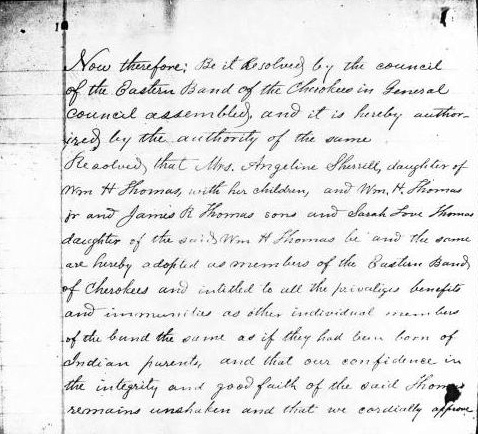|
Cherokees Adopt William Holland Thomas's Descendants

Recommended
Reading: James
Mooney's History, Myths, and Sacred Formulas of the Cherokees (768 pages). Description: This
incredible volume collects the works of the early anthropologist James Mooney who did extensive studies of the Eastern
Cherokee Nation (those who remained in Appalachia) at the turn of the century. The introduction is by Mooney's biographer and gives
a nice overview of both Mooney and the Cherokee Nation, as well as notes on Mooney's sources. It then goes straight into the
first book "Myths of the Cherokee", which starts with a history of the Cherokee Nation. Continued below...
It progresses from the earliest days, through de Soto, the Indian wars,
Tecumseh, the Trail of Tears, the Civil War and ultimately to 1900. Continuing, it explores Cherokee mythology and storytellers.
This book is truly monumental in its scope and covers origin myths, animal stories, Kanati and Selu, the Nunnehi and Yunwi'Tsundi
(little people), Tlanuwa (thunderbirds), Uktena (horned water snake), interactions with other Nations and numerous other myths,
as well as local legends from various parts of the Southeast (North Carolina, Tennessee, Georgia, etc). There is also a section
of herbal lore. Mooney closes with a glossary of Cherokee terms (in the Latin alphabet rather than the Sequoya Syllabary)
and abundant notes. We advance to the next book, Sacred Formulaes of the Cherokee, which covers a number of magical texts
amongst the Cherokee Nation. This book does a wonderful job talking about such manuals, mentioning how they were obtained,
going into depth about the Cherokee worldview and beliefs on magic, concepts of disease, healing ceremonies, practices such
as bleeding, rubbing and bathing, Shamanism, the use of wording, explanations of the formulae and so forth. It then gives
an amazingly varied collection of Cherokee formulae, first in the original Cherokee (again, in the Latin alphabet) and then
translated into English. Everything from healing to killing witches, to medicine for stick ball games, war and warfare. Both
books include numerous photographs and illustrations of famous historical figures, Cherokee manuscripts and petroglyphs and
a map of Cherokee lands. Again, this is a truly massive book and even today is considered one of the essential writings of
Cherokee religion. Anyone with an interest in the subject, whether anthropologist, descendant of the Cherokee or just a curious
person interested in Native culture, should definitely give this book a read. I highly recommend it.
Editor's Recommended
Reading: Western
North Carolina: A History from 1730 to 1913 (Hardcover: 679 pages). Description: From
the introduction to the appendix, this volume is filled with interesting information. Covering seventeen counties—Alleghany,
Ashe, Avery, Buncombe, Cherokee, Clay, Graham, Haywood, Henderson, Jackson, Macon, Madison, Mitchell, Swain, Transylvania,
Watauga, and Yancey—the author conducted about ten years searching and gathering materials. Continued below...
About the Author: John Preston Arthur was born in 1851 in Columbia, South Carolina.
After relocating to Asheville, North Carolina,
in 1887, he was appointed Secretary of the Street Railway Company, and subsequently the Manager and Superintendent until
1894. Later, after becoming a lawyer, he was encouraged by the Daughters of the American
Revolution (D.A.R.) to write a history of western North Carolina.
Recommended Reading: The Cherokee Nation: A History.
Description: Conley's book, "The Cherokee Nation: A History" is an eminently readable,
concise but thoughtful account of the Cherokee people from prehistoric times to the present day. The book is formatted in
such a way as to make it an ideal text for high school and college classes. At the end of each chapter is a source list and
suggestions for further reading. Also at the end of each chapter is an unusual but helpful feature- a glossary of key terms.
The book contains interesting maps, photographs and drawings, along with a list of chiefs for the various factions of the
Cherokee tribe and nation. Continued below...
In
addition to being easily understood, a principal strength of the book is that the author questions some traditional beliefs
and sources about the Cherokee past without appearing to be a revisionist or an individual with an agenda in his writing.
One such example is when Conley tells the story of Alexander Cuming, an Englishman who took seven Cherokee men with him to
England in 1730. One of the Cherokee, Oukanekah, is recorded as having said to the King of England: "We look upon the Great
King George as the Sun, and as our Father, and upon ourselves as his children. For though we are red, and you are white our
hands and hearts are joined together..." Conley wonders if Oukanekah actually said those words and points out that the
only version we have of this story is the English version. There is nothing to indicate if Oukanekah spoke in English or Cherokee,
or if his words were recorded at the time they were spoken or were written down later. Conley also points out that in Cherokee
culture, the Sun was considered female, so it is curious that King George would be looked upon as the Sun. The "redness" of
Native American skin was a European perception. The Cherokee would have described themselves as brown. But Conley does not
overly dwell on these things. He continues to tell the story using the sources available. The skill of Conley in communicating
his ideas never diminishes. This book is highly recommended as a good place to start the study of Cherokee history. It serves
as excellent reference material and belongs in the library of anyone serious about the study of Native Americans.
Try the Search Engine for Related
Studies: Cherokee Indian Resolution to Adopt William Holland Thomas's Descendants Original Copy, Transcription of Adoption
Papers, History Cherokee Chief William Holland Thomas, Cherokee Indian Documents
|

